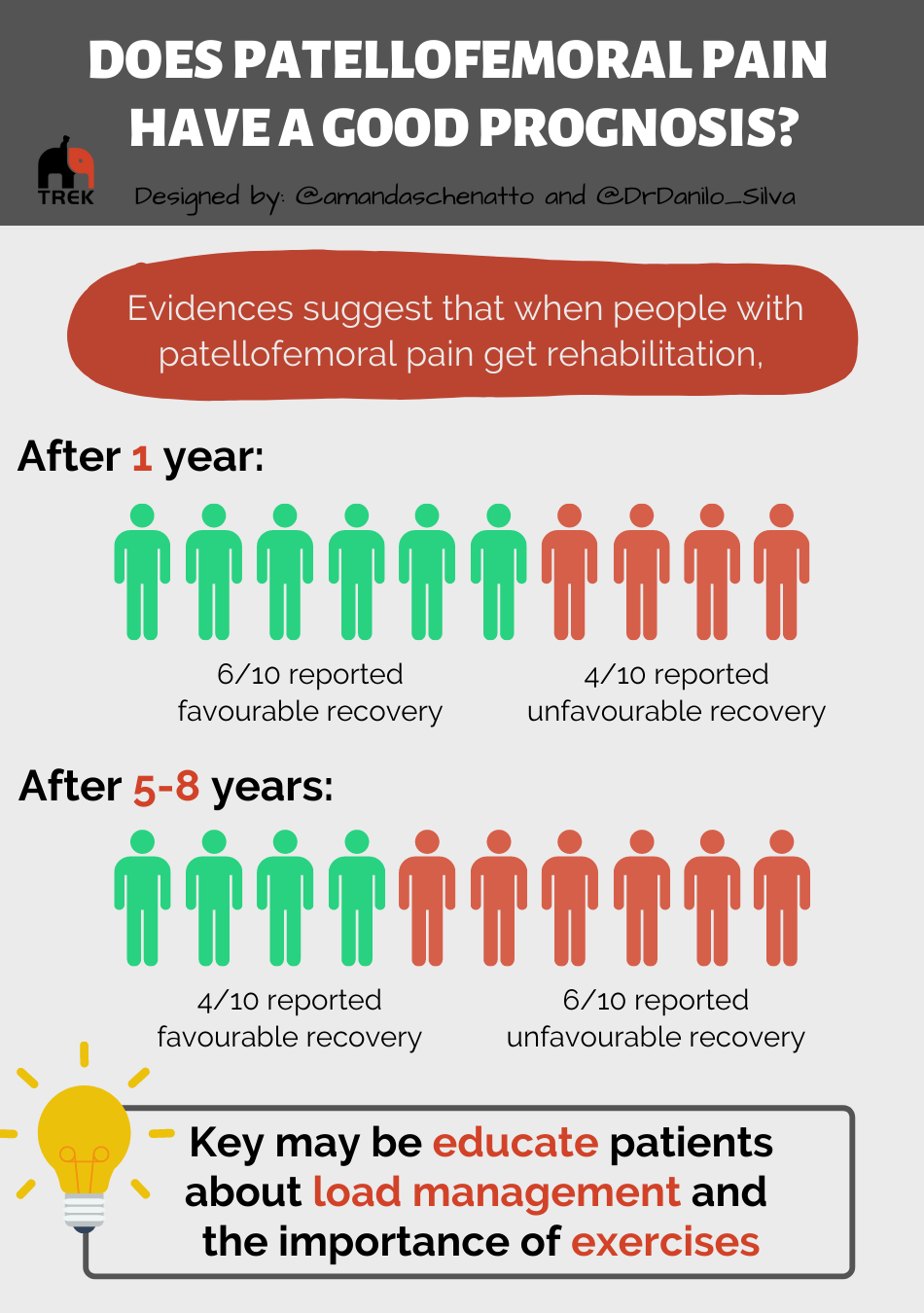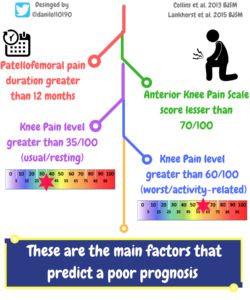Traditionally, patellofemoral pain has been considered a self-limiting condition. However, a growing body of evidence indicates that it is common for pain to continue in the long-term.
In this section, you will find information about the prognosis of patellofemoral pain and about what factors are likely to predict a poor prognosis.
 Studies assessing young adults with patellofemoral pain indicate high rates of unfavorable recovery in the long-term.1,2 More specifically, in a group of people with patellofemoral pain who underwent evidence-based physical therapy treatment, 40% reported an unfavorable recovery after 1-year.1 In a more recent study, which evaluated people with patellofemoral pain at 5 to 8 years after treatment, this rate was even higher: 57% of patients reported an unfavorable recovery.2
Studies assessing young adults with patellofemoral pain indicate high rates of unfavorable recovery in the long-term.1,2 More specifically, in a group of people with patellofemoral pain who underwent evidence-based physical therapy treatment, 40% reported an unfavorable recovery after 1-year.1 In a more recent study, which evaluated people with patellofemoral pain at 5 to 8 years after treatment, this rate was even higher: 57% of patients reported an unfavorable recovery.2
The prognosis of adolescents with patellofemoral pain seems to be similar or even worse than adults with patellofemoral pain: about 50% to 90% of adolescents report persistence of symptoms 1 to 20 years after the initial diagnosis.3,4,5,6
Evidence indicates that the duration of patellofemoral pain may vary, however, it reinforces that this is not self-limiting condition. Patellofemoral pain treatments including exercise and adjunct treatments (such as foot orthoses, knee brace, patellar taping) can be effective in short, medium and long-term. It is possible that the key factor for better long-term outcomes is to continue using these effective treatments, individually targeted to the patient’s impairments. Also, educate patients to continually manage their exercise load and address risk factors even after treatment may be a good option to avoid patellofemoral pain recurrence.
Some evidence demonstrates that the presence of certain factors may indicate a worse prognosis for the condition even after treatment.1,2
- Longer symptom duration (> 12 months) and worse self-reported function (Anterior Knee Pain Scale -AKPS score of less than 70/100) predicts poor prognosis at 5–8-years after treatment.2
- In addition, the severity of usual or resting pain (Visual Analogue Scale score greater than 35/100) and the severity of worst or activity-related pain (Visual Analogue Scale score greater than 60/100) predicts poor prognosis at 1-years after treatment.1
Identifying which factors are associated with chronicity and symptoms severity is important to develop preventive strategies aiming to improve the long-term prognosis of patellofemoral pain.
In addition, decreasing the chances of patellofemoral pain chronicity and recurrence is particularly important, since that several studies and researchers have suggested that patellofemoral pain may be a condition that precedes the development of patellofemoral osteoarthritis.
Important note: Health professionals need to educate patients that patellofemoral pain is not always self-limiting, especially those with long symptoms duration (>12 months) and worse symptoms and function.
Watch the video below with Dr. Simon Lack, answering the most common questions about this topic:

Now that you have reviewed everything about the prognosis of patellofemoral pain, test your knowledge by taking the quiz below.
References
- Collins et al. 2013. Prognostic factors for patellofemoral pain: a multicentre observational analysis.
- Lankhorst et al. 2015. Factors that predict a poor outcome 5–8 years after the diagnosis of patellofemoral pain: a multicentre observational analysis.
- Rathleff et al. 2013. Half of 12-15-year-olds with knee pain still have pain after one year.
- Rathleff et al. 2016. Is knee pain during adolescence a self-limiting condition? Prognosis of patellofemoral pain and other types of knee pain.
- Stathopulu & Baildam. 2003. Anterior knee pain: a long-term follow-up.
- Nimon et al. 1998. Natural history of anterior knee pain: a 14- to 20-year follow-up of nonoperative management.

